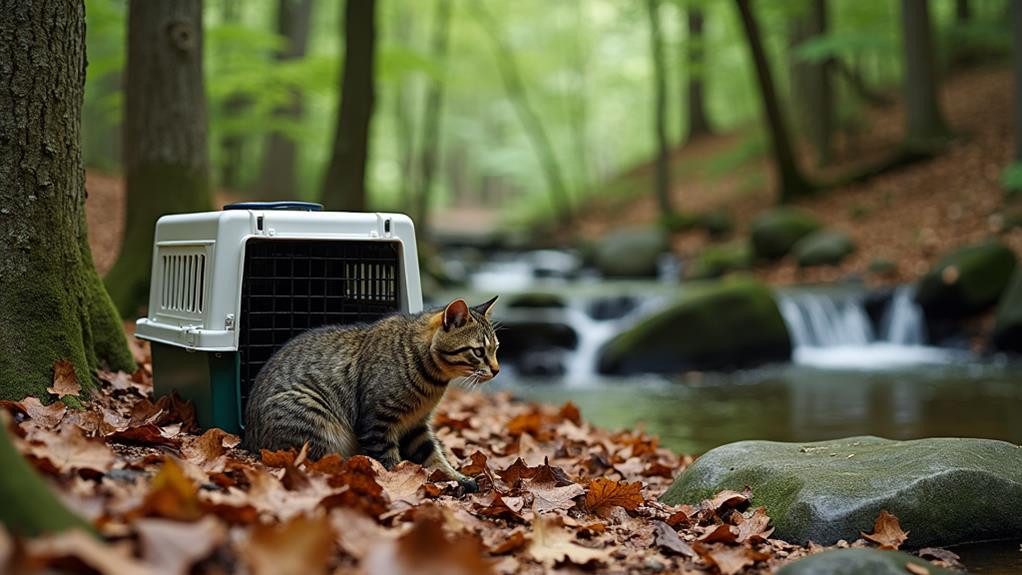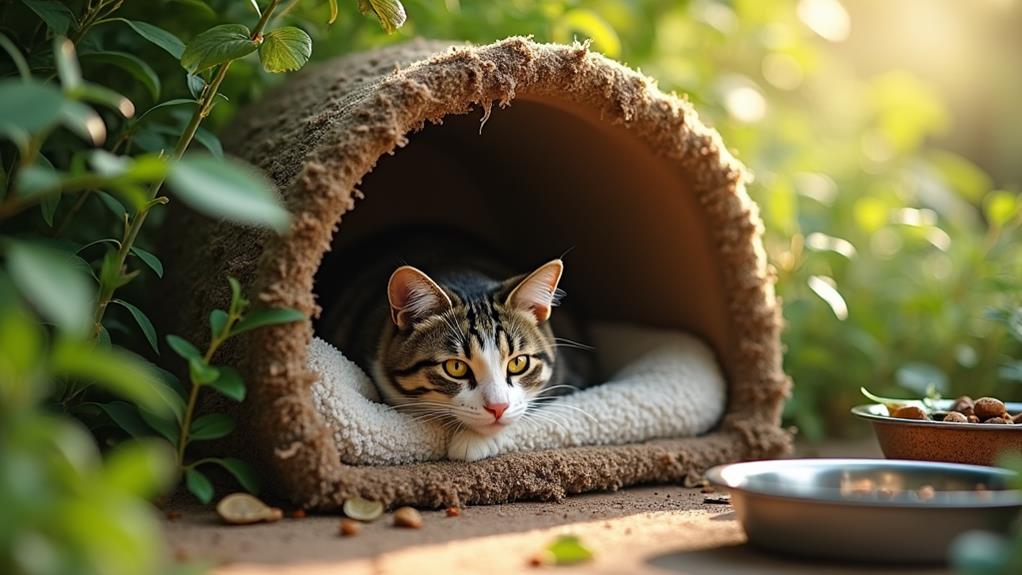How Far Should You Relocate a Feral Cat? Best Practices for TNR

When relocating a feral cat, move it only if necessary, ensuring the new site is 1-2 miles away to prevent it from returning to its original territory. Feral cats thrive on familiar ground, and moving them disrupts social bonds and introduces significant health risks. Before relocating, conduct thorough assessments and consider effective alternatives like Trap-Neuter-Return (TNR), which allows the cat to stay in its known environment. If relocation is unavoidable, consider confining the cat for 6-8 weeks to help it adjust to its new surroundings. There's much more to learn about best practices and ensuring ongoing support.
Understanding Feral Cat Behavior
In terms of feral cat behavior, recognizing their territorial nature is essential. Feral cats are deeply connected to their established home range, which they rely on for food, shelter, and safety. This territorial instinct means any relocation can be tremendously stressful for them. They have an impressive sense of navigation, often trying to return to their original territory even if they've been moved miles away. This natural inclination to return highlights the challenges posed by relocation efforts.
When considering TNR (Trap-Neuter-Return) programs, it's important to understand the significance of these territorial and social bonds. Within feral cat colonies, social bonds play a significant role in their daily behavior and communal living. Disrupting these bonds through relocation can lead to considerable stress and disorientation. This stress not only affects their behavior but can also negatively impact their health, increasing their vulnerability to illness or even death.
Risks of Relocation
Recognizing the complexities of feral cat behavior, it's vital to address the significant risks tied to their relocation. Moving a feral cat from its original territory often leads to high mortality rates, with studies showing that up to 50% of relocated cats may not survive. This grim statistic highlights how dangerous relocation can be, primarily because cats frequently attempt to return home, exposing themselves to traffic, predators, and hostile humans along the way. Such dangers are a stark reality they face outside their familiar grounds.
Stress is another important factor to evaluate. The upheaval caused by relocation can induce severe stress in feral cats, leading to different health issues, disorientation, and even behavioral problems. These stress-induced challenges make it difficult for them to acclimate to new surroundings, resulting in a higher likelihood of failure, especially if they're not confined for at least four weeks post-relocation.
Moreover, the belief that relocation improves their living conditions is often misguided. Many cats find themselves in unsuitable environments, where new threats replace old ones. Understanding these risks is vital when evaluating relocation as a solution for feral cats. These challenges demand careful thought and planning to guarantee their well-being.
Effective Alternatives to Relocation

When considering the future of feral cats, it's important to investigate effective alternatives to relocation that prioritize their well-being and stability. Trap-Neuter-Return (TNR) stands out as a humane and effective method. By allowing feral cats to remain in their familiar territories, TNR prevents population growth through sterilization. This approach not only benefits the cats but also supports the community by reducing the number of strays over time.
To further improve the welfare of feral cats, providing ongoing support to established colonies is significant. Regular feeding and veterinary care can address community concerns, ensuring the cats are healthy and less likely to cause disturbances. Maintaining original feeding locations and shelters helps alleviate potential conflicts, allowing these animals to thrive without the stress of relocation.
Community engagement plays an important role in the success of TNR programs. Educating residents about the benefits of TNR can foster positive relationships with feral cat populations, reducing hostility and misconceptions. By implementing managed TNR programs, you can effectively reduce stray numbers and preserve local ecosystems. Relocation often increases risks and stress for cats, making these alternatives not only practical but compassionate solutions.
Identifying Justifiable Relocation Scenarios
While TNR programs offer a humane solution for managing feral cat populations, there are scenarios where relocation becomes necessary to guarantee their safety and well-being. If community cats face immediate threats like hazardous environments such as highways or chemical exposure, relocation is imperative. In these cases, finding a new location that's at least 1-2 miles away helps prevent them from returning to their original colony, safeguarding their safety.
High levels of hostility from local residents can also justify relocation. If community cats encounter aggression or threats from predators, their well-being is at risk, making relocation critical. Another scenario is when the original colony site faces demolition or significant renovations. Such changes can destroy the cats' habitat, making it significant to find a new location for their continued safety.
Additionally, if a caregiver can no longer provide care without a replacement, relocating the cats becomes necessary. This guarantees they continue to receive the care they need. Relocation, although challenging, can be the best option when these threats exist. Always prioritize the cats' safety and welfare, ensuring their new location offers a secure and supportive environment.
Safe Relocation Protocols

To guarantee a smooth feral cat relocation, you should initially assess the colony's composition thoroughly. It's vital to identify socialized cats and kittens, as they may require special attention during the process. A safe relocation begins with humane trapping and precise transport procedures that minimize stress. Confirm each cat is secure to prevent any escape or injury. Once you've captured the entire feral cat colony, focus on finding a new outdoor home that can accommodate all of them together.
Prioritize locations away from busy roads and areas with significant wildlife dangers. This helps reduce the risk of accidents and potential encounters with predators. Conduct a thorough safety inspection of the new environment, verifying it's suitable for the cats' needs. Provide adequate shelter options to protect them from harsh weather conditions.
Maintaining open communication with the new caregivers is vital to offer ongoing support. This confirms the cats' continued well-being and helps address any issues that may arise post-relocation. Safe relocation isn't just about moving the cats; it's about making sure they thrive in their new setting. With careful planning and execution, you can make a positive impact on their lives.
Choosing a Suitable New Location
After securing the safe capture and handling of each feral cat, the next focus is on selecting a new location that meets their needs. Start by finding a site at least 1-2 miles from their original territory to reduce the chance they'll try to return. It's essential to choose a safe environment, away from busy roads, chemical exposure, and wildlife threats. Look for places like barns or stables which offer ample shelter and resources. These locations provide enough space for the entire feral cat colony to stay together and maintain their social bonds.
Assess the new location carefully. Confirm there's accessibility to food and water sources, important to the cats' survival. A committed caretaker should be in place to offer ongoing support, making sure that the cats' needs are consistently met. This person plays a significant role in the success of the relocation process.
To find suitable relocation sites, utilize local community channels. Advertise to identify homes willing to accept the feral cat colony. By doing this, you increase the chances of finding a location that provides the right conditions for the cats to thrive. This preparation sets the stage for a successful change.
Confinement and Acclimation Needs

Successfully relocating feral cats requires an important phase of confinement and acclimation. After the move, it's necessary to confine the cats in a large enclosure for at least 6-8 weeks. This period helps them acclimate to their new environment and minimizes stress-related issues. Providing a secure hiding place within the enclosure makes the cats feel comfortable, reducing anxiety during this change.
During confinement, guarantee the cats have access to clean water and fresh food. Offering appealing food, like canned varieties, can encourage them to bond with their new surroundings. Regularly monitor for any escape attempts, as maintaining their presence is significant for a successful adjustment. If a cat manages to wander off, set out food and litter to attract it back.
Hygiene plays an important role in the acclimation process. Maintain a regular cleaning schedule for litter and guarantee a consistent feeding routine. These practices promote a healthy environment and help the cats feel at ease. By providing a structured and supportive atmosphere, you'll enable the cats to adjust smoothly and integrate successfully into their new habitat.
Ensuring Ongoing Cat Care
Establishing a sustainable care routine is fundamental for the well-being of relocated feral cats. As a caregiver, your role involves daily feeding, monitoring health, and providing adequate shelter. Open communication is key. Make certain you clearly understand your responsibilities and the expectations set out in a detailed caregiver agreement. This agreement outlines commitments like ongoing care and guaranteeing the cats' safety and health.
Regular check-ins are significant. Stay in contact with those involved in the relocation to assess how well the cats are adapting. This helps foster a supportive relationship and guarantees that any health issues are promptly addressed. Veterinary care is critical, including spaying/neutering and routine health checks. Make certain you have access to resources and guidance on these matters.
Engaging the community can improve your efforts in providing humane cat care. Sharing information about the relocation process and the importance of maintaining these practices encourages support and cooperation. By involving the community, you help create a network that values the cats' well-being. Your dedication as a caregiver plays an instrumental role in guaranteeing the relocated cats thrive in their new environment.
Engaging Community Support

Community involvement is vital when managing feral cat populations through TNR programs. Engaging community support guarantees that local residents contribute valuable resources, such as food and shelter, to maintain feral cat colonies. By participating in educational outreach initiatives, you can help dispel myths about these cats, promoting an understanding of their ecological role and the benefits of humane management. This fosters a compassionate environment where TNR programs can thrive.
Collaborating with community organizations like animal shelters and local businesses amplifies your efforts. These partnerships can secure funding for necessary supplies and veterinary care, critical for the success of TNR programs. Hosting community events, such as informational workshops or volunteer days, encourages local participation, making residents feel invested in the welfare of feral cats. This collective involvement leads to more effective population management.
Building relationships with local government officials is another strategic move. By doing so, you can facilitate policy changes that support TNR efforts and refine community regulations regarding feral cat care. Such policy changes guarantee a structured approach to managing feral cat colonies, ultimately benefiting both the cats and the community. By actively engaging and collaborating, you create a sustainable and supportive environment for TNR programs.
Recommended Resources and Guidance
Building on community support, having the right resources and guidance is key when relocating feral cats. Making sure the cats adapt smoothly to their new environment involves careful planning. Start by consulting materials like the "TNR Handbook" from Neighborhood Cats. This guide offers thorough strategies for relocation, emphasizing the importance of evaluating the safety and suitability of the new site. Ideally, relocate feral cats within a 1-3 mile radius of their original location to help minimize stress and prevent disorientation.
Engage with organizations like Alley Cat Allies for supplementary support and resources. They can provide valuable insights and assistance, making sure both the caretakers and the cats have what they need. Community outreach is also crucial. Educating the public about TNR and the benefits of maintaining established territories helps alleviate misunderstandings and fosters a supportive environment.
Once the relocation process is underway, regular follow-ups with new caretakers are fundamental. These check-ins make sure the cats' continued welfare and provide necessary resources, such as food and veterinary care. By focusing on community engagement and using trusted resources, you can guarantee a smoother changeover and a better quality of life for relocated feral cats.




